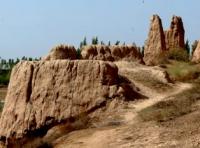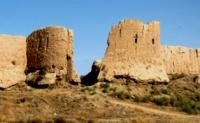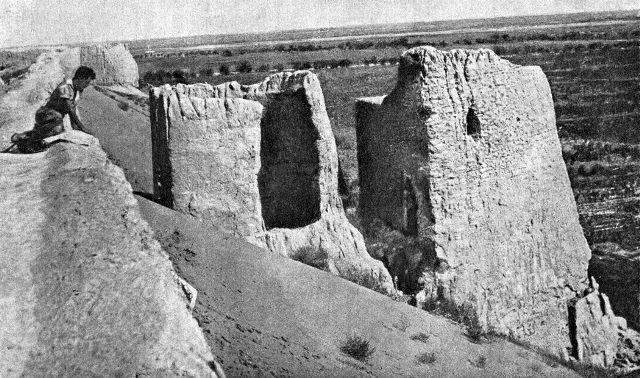Вы здесь
Fortress Guldursun (Big).



Photo tours to monuments of Karakalpakstan.
“I don’t think,” he says elsewhere, “that there is a city in the world similar to the main city of Khorezm in terms of the abundance of wealth and the size of the capital, a large population and proximity to goodness and the fulfillment of religious precepts and faith.”
Yakut.
Visiting to monuments of Karakalpakstan.
The Guldursun Fortress (Bolshaya) is located on a natural hill 101.9 meters above sea level, located in the western part of the Kumbaskak sand, in the northern part of the Angyt village, 2.6 kilometers northeast of the Katta-Guldursun village, 13.8 kilometers to the north and slightly west of the village of Turtkul in the Ellikala region of the Republic of Karakalpakstan.
Guldursun (Big), dates back to the IV-III centuries BC, XII-XIII centuries AD. Surveyed in 1937 by archaeologists Ya. G. Gulyamov, in 1940 the research was continued by S. P. Tolstov and in 1987 - 1994 by O. T. Dospanov.
Big Guldursun is one of the largest border fortresses of Khorezm, built on the basis of a desolate ancient fortress. In plan, it is an irregular rectangle measuring 350 x 230 meters, oriented with its corners to the cardinal points.
Inside, during archaeological excavations, a large number of antique and medieval ceramics, bronze crafts and decorations, Antique and medieval coins were found. Judging by the finds of coins, it can be determined that the last period of the monument's existence dates back to 1220.
By the time of the reign of Muhammad Khorezmshah, i.e. by the time of the invasion of Mongolian troops into Khorezm. The entrance to the fortress is located in the middle of the southeastern wall and is protected in the plan by a rectangular maze.
Legend about the ancient settlement of Guldursun.
A local native, a young Karakalpak scientist U. Kozhurov told us the tale he heard in childhood about Guldursun (S.P. Tolstov). “Once Guldursun, according to old-timers, was called Gulistan -“ Flower garden of roses ”.
It was a rich city with a blooming area full of water. The city was ruled by an old padishah who had a beautiful daughter named Guldursun. And then the happy city was in trouble: hordes of Kalmyks came from the desert, destroying everything in their path.
The Kalmyks devastated the blossoming fields and gardens and surrounded the city in a dense ring. The inhabitants defended themselves courageously, and the enemies were unable to overcome their resistance.
Months passed, and an even more terrible enemy - hunger - came to the aid of the conquerors. Stocks have run out. People were dying in the streets. The thinned defenders barely held their weapons in their weakened hands.
Then he summoned the padishah to a council of his nobles and generals. And there was one among them who offered to try the last means of salvation. It was a cunning plan. The besieged Gulistanians secretly brought the best of the surviving few more bulls to the palace, fed him the last wheat from the royal bins to his fill, and let him out of the town wall.
And not only the besieged, but also the besieged suffered from hunger. Having devastated the district, the Kalmyks ate everything that could be eaten during the siege for many months, and in the camp they began to talk about the inevitability of lifting the siege.
The hungry Kalmyks caught and killed the bull, and when they saw that its stomach was full of selected wheat grain, they were confused: “If they are feeding the cattle like that, what other supplies they have! - shouted the warriors.
"The siege is hopeless, the city is impregnable, we must get out before we starve to death." The Kalmyk commanders decided so, and in the camp preparations began for the return trip. But the daughter of the padishah, Guldursun, decided otherwise.
For many months she watched from the walls the leader of the Kalmyks, a handsome young man, a brave knight - the son of the Kalmyk king. An irrepressible passion for the leader of the enemies of her people flared up in her heart.
And when she saw that the cunning of the besieged was successful, that the roar of the loaded camels stood over the enemy's camp, countless yurts of Kalmyks disappeared one after another, that it would not take a few hours before they left and the handsome tsarevich would leave with them forever, she did an unworthy deed.
With a devoted servant, she sent a letter to the Kalmyk knight, in which she described her passion for him and revealed the secret of the Gulistan people. "Wait one more day," she wrote, "and you will see for yourself that the city will surrender."
The Kalmyks unloaded their camels, and countless campfires lit up again in the night. And when at dawn the people of Gulistan saw that the enemies had seized the city even closer, that their cunning was not crowned with success, they fell into despair, and the town dying of hunger surrendered to the mercy of the victor.
The town was plundered and burned, the inhabitants were partly killed, partly taken into slavery. The traitor Guldursun was brought to the prince. He looked at her and said: “If, because of an unworthy passion for the enemy of her homeland, she betrayed her people and her father, what will she do to me if someone else awakens her passion?
Tie her to the tails of wild stallions so that she can no longer betray anyone."
And the horses tore the body of Guldursun into small pieces and scattered it across the fields. And from the cursed blood of the traitor this place was desolate and they began to call him not Gulistan, but Guldursun."
Geographic coordinates of the Guldursun fortress (Big): N41 ° 41'35.57 "E60 ° 58'52.16"

Authority:
1. Gulyamov Ya.G. "The history of irrigation in Khorezm from ancient times to the present day" Tashkent, 1957.
4. Terenozhkin A.I. "Archaeological exploration in Khorezm." CA No. 6, 1940.
5. Tolstov S.P. "Antiquities of Upper Khorezm". VDI, No. 1, 1941.
6. Tolstov S.P. "Ancient Khorezm". M., 1948.







